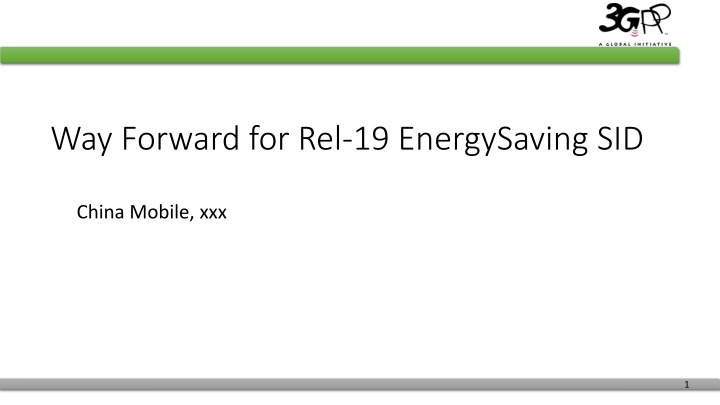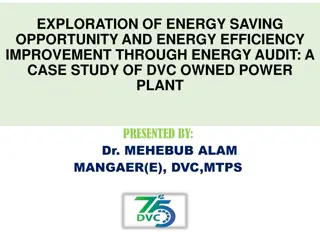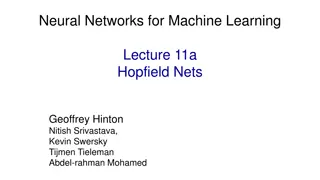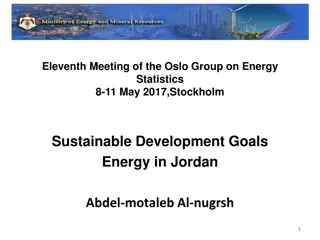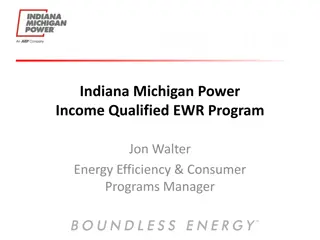Energy Saving Solutions in 5G Networks
Summary of current discussions in SA2 regarding energy saving strategies in 5G networks. Focus on calculating energy consumption per specific UE, monitoring, and adjusting network policies. Explore the challenges and proposed solutions for optimizing energy consumption in 5G infrastructure.
Download Presentation

Please find below an Image/Link to download the presentation.
The content on the website is provided AS IS for your information and personal use only. It may not be sold, licensed, or shared on other websites without obtaining consent from the author.If you encounter any issues during the download, it is possible that the publisher has removed the file from their server.
You are allowed to download the files provided on this website for personal or commercial use, subject to the condition that they are used lawfully. All files are the property of their respective owners.
The content on the website is provided AS IS for your information and personal use only. It may not be sold, licensed, or shared on other websites without obtaining consent from the author.
E N D
Presentation Transcript
Way Forward for Rel-19 EnergySaving SID China Mobile, xxx 1
Summary of current status of SA2 discussion In SA2, for EnergySaving, TR23.700-66 includes 11 solutions for KI#1, 18 solutions for KI#2, and 17 solutions for KI#3. KI#1 is about the architecture of Energy Consumption information calculation, and the basis for KI#2&KI#3. SA2 mainly discuss one issue that how to monitor and calculate the energy consumption information for specific UE(some other granularity e. g. per UE per AF, but the per specific UE is the basic requirement). And in TR23.700-60 Clause 8.1, the main idea is Specific UE energy consumption within certain period=ECupf+ECRAN; ECupf=(UE traffic volume) /(UPF Node level traffic volume)*(UPF Node level EC); ECRAN=(UE traffic volume) /(RAN Node level traffic volume)*(RAN Node level EC); NOTE: the above traffic volume, Energy Consumption is calculated for certain period. The above calculation formula can reflect the energy consumption status of specific UE in 5GS to some extent. However, the UEs in the same UPF/RAN node may have the same energy consumption per bit. So this is also an average of UEs energy consumption of the specific Nodes. Most companies in SA2 think the above formula can reflect the UE energy consumption information/status in the 5GS, and it is benefit to use this information to adjust the network policies e.g. UE policy, BDT policy etc., Some companies in SA2 think this formula just can reflect the UE energy consumption in statistics, since the EC information is from OAM per Node, and has no relationship with the UE access to specific RAN node. Therefore think the SA5 may take the lead to do the study work. 2
Summary of current status of SA2 discussion Observation The consensus is hard to achieve. And in some offline discussion, some companies suggest if the RAN can report the specific UE level energy consumption information to 5GC, then 5GC may get a better idea of this E2E per specific UE level energy consumption. However, this kind of reporting should not be so frequent to avoid the additional energy consumption. Another discussion aspect is how the operators can utilize the per specific UE level energy consumption information. 1) This information should be not related with charging system, i.e. operators will not use this information for charging; 2) Operators can adjust the network configuration based on the UE level energy consumption. 3) Frequent QoS adjustment is not preferred, but some policy information for UE level is preferred, e.g. Slice, BDT time. 4) Renewable information is expected to be included, which need coordination between SA2 and SA5. 3
Some principles of the EnergySaving in 5GS Some principles we would like to provide when do the EnergySaving in 5GS. 1) Energy consumption information is different than traffic volume. And the EC information cannot be so precise since it is kind of a statistics information for a period but can reflect the energy consumption status actually. Therefore the calculation and reporting of energy consumption info per specific UE can be minutes, to avoid the additional energy consumption in 5GS. 2) Because of the non-precise, this information should not be integrated into charging system. 3) In order to make the energy consumption information closer to the actual network status to support this UE, it is suggested the RAN can report the RAN side EC information based on the traffic volume, PRBs, signal strength, or other parameters if needed. 4) EC information exposure can reflect the UE energy status in the network, and the information is valuable no matter it is for network configuration optimization, or exposure to 3rdparty or NPN owner to reflect the UE s carbon footprint. 4
Proposal for the EnergySaving in Rel-19 In order to move forward, in August meeting it is proposed: 1) In SA2, It is suggested to agree the WID, and agree to establish an architecture for EC information monitoring and calculation in SA2, i.e. new network functionality is introduced to support E2E specific UE EC information monitoring and calculation. a. For core network side, it is based on the traffic volume, and node level EC information; b. For RAN side, it is suggested RAN can report per UE level EC information based on traffic volume, PRBs, signaling strength, or other parameters, and the reporting frequency should not be high, in order to avoid additional energy consumption. 2) One LS to RAN WGs to inform the SA2 discussion and decision, and check RAN progress to see whether the above requirement can be fulfilled. 5
Annex Initial analysis for RAN side reporting per UE level EC information 1) RAN may consider the following information to calculate the per UE level RAN EC information Collected by NG-RAN PRB usage for UL and DL, which can reflect the radio resource for the UE, may need enhancement in RAN WGs. UE report to NG-RAN, already support RSRP (Reference Signal Received Power), which can reflect the strength of desired signal; and the distance between UE and RAN node. SINR (Signal-to-Interference-plus-Noise Ratio), which can reflect the quality of desired signal; CQI (Channel Quality Indicator), PHY channel quality 6
